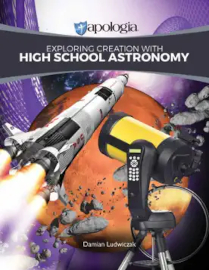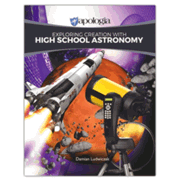Exploring Creation with High School Astronomy is described by the publisher as an elective course that gives students a chance to explore the subject without the constraints of typical high school courses. That means there are no experiments, exams, or suggested schedules.
As an elective course for high school, it is self-contained in one book, making it easy to use for independent study. The softcover book is heavily illustrated in full color. It is also available as a Kindle edition or an Apple ebook, replicas of the print edition rather than the text stripped of color and images.
The course is presented in 14 modules, and students are encouraged to work through it at their own pace. To aid student retention, each module includes one or more sets of “On Your Own” questions for students to answer. The answers, with 69 pages of detailed explanations, are at the back of the book, so there is no separate answer key. The author, Damian Ludwiczak, explains in the “Welcome” at the beginning of the book that students should try to answer the questions on their own first, and if they get one wrong, they can study the solution to discover their error.
The course has a strong high school math component incorporating geometry, algebra, trigonometry, and calculus. Ludwiczak walks students through equations and calculations, explaining most math symbols and terms as he applies math to astronomical events. This is important because we understand the universe through observation, math, and models. Ludwiczak doesn’t just tell students that a star is so many light years away, he walks them through the process of determining that distance. This is true for all the mathematical language used to comprehend the universe. How do we know how hot a star is? How do we evaluate distant galaxies? And how do we learn about the planets in our own solar system? Rather than just list the facts, Ludwiczak goes further and explains how scientists arrived at the facts.
For example, on pages 147 through 150, he explains the Orbital Mechanics Properties of Mercury. He presents the equation for determining the orbital period of a planet, defines the abbreviations in the equation, explains the values that need to be plugged in, and works out the solution.
The On Your Own questions include some that require students to apply the math, such as question 6.8 which asks,
As an astronomer, you determine that an object in our solar system is 1.02 AU from Earth and has an observed angular size of 0.0089°. What would be your estimate for the diameter of this object?
Although many high school students will have the mathematical skills to answer this question, those who don't can still gain knowledge from looking at and following along with the detailed solutions at the back of the textbook. In fact, at the beginning of the textbook on page vi, Ludwiczak says,
Some questions are mathematical. If your math skills are not ready for these, you do not need to complete them in order to receive credit for this course. Do your best to understand the concepts that the math shows.
If students try to skim over the math without working through the examples and problems, they will lose significant course content that helps them learn how astronomical scientific facts are mathematically determined. Consequently, I recommend this course for students who have completed geometry and two years of algebra and have had at least an introduction to trigonometry and functions within those courses or others. Without sufficient mathematical background, they might be baffled as early as page 52, where Ludwiczak explains the parsec with a trigonometric equation that doesn’t explain the meaning of the term Tan (which is used in the equation). Nevertheless, the publisher intentionally created this course without labs, study guides, and exams, so students are not tested and do not need to turn in work. This approach encourages students who are not strong in math to get what they can from the math and concentrate on the other content.
Topics Covered
I’ve emphasized the math content thus far since it is a significant factor, but of course, there is also content not based on math throughout the course. The first module discusses space, interstellar space, and the universe, including topics such as dark matter, dark energy, black holes, and wormholes. I found this first module fascinating! The second module recaps a brief history of astronomy. The third module teaches some of the scientific principles and math are used throughout the course, such as the Astronomical Unit, the Light Year, gravity, and rotation. The fourth module looks at the historical development of the heliocentric model for our solar system, a perfect lead-in to the fifth module, which focuses on the sun, its composition, its effects, and electromagnetic energy. Module six focuses on each of the inner planets—Mercury, Venus, Earth, and Mars—while the outer planets—Jupiter, Saturn, Uranus, and Neptune—are studied in the ninth module. Students learn about dwarf planets and the asteroid belt in the tenth module. Modules 7 and 8 discuss the moon and telescopes. Modules 11 through 14 move beyond our solar system to cover the universe, stars, galaxies, and celestial navigation.
Aside from a few comments about God as creator near the beginning, I didn’t find other faith-based content.
Apologia hosts an online, password-protected “Book Extras” page for this course where students will find links to many websites for each module with additional information, videos, illustrations, and related math practice. The password is near the front of the textbook.
Summary
This is a thorough astronomy course that should especially suit students who are serious about learning astronomy for their own benefit or in preparation for future studies.









